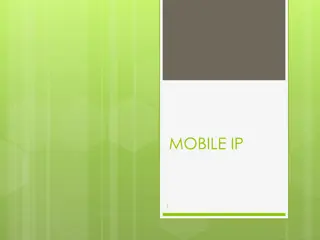MAAP Protocol Overview in IEEE 1722: Address Acquisition and Message Format
The MAAP (Multicast Address Acquisition Protocol) is defined in IEEE 1722 for time-sensitive applications in bridged local area networks. It involves acquiring multicast addresses through claiming, probing, and defending messages. MAAP enables dynamic allocation of addresses and defending against conflicts by sending MAAP_ANNOUNCE and MAAP_DEFEND messages. The protocol specifies message formats and usage of multicast MAC addresses for AVTP. Compatibility considerations for extending the protocol are also outlined.
Download Presentation

Please find below an Image/Link to download the presentation.
The content on the website is provided AS IS for your information and personal use only. It may not be sold, licensed, or shared on other websites without obtaining consent from the author.If you encounter any issues during the download, it is possible that the publisher has removed the file from their server.
You are allowed to download the files provided on this website for personal or commercial use, subject to the condition that they are used lawfully. All files are the property of their respective owners.
The content on the website is provided AS IS for your information and personal use only. It may not be sold, licensed, or shared on other websites without obtaining consent from the author.
E N D
Presentation Transcript
omniran-19-0011-00-CQ00 MAC Address Acquisition Protocol Antonio de la Oliva (UC3M)
omniran-19-0011-00-CQ00 MAAP Defined in IEEE 1722: IEEE Standard for a Transport Protocol for Time- Sensitive Applications in Bridged Local Area Networks It is defined to self-claim multicast addresses Protocol based on claiming, probe and defend messages Acquisition of addresses: Select an address range from the MAAP dynamic allocation pool. Send a series of MAAP_PROBE protocol data units (PDUs) to determine whether the address range is already in use. Listen for MAAP_DEFEND PDUs indicating the address range is in use. Repeat the above steps until an unused address range has been found.
omniran-19-0011-00-CQ00 MAAP Defending addresses: Send MAAP_ANNOUNCE PDUs periodically to inform the network of address ranges that are currently in use. This allows networks that are joined after the MAAP has been run to identify conflicts. Listen for MAAP_PROBE PDUs and send MAAP_DEFEND PDUs in response to any address ranges that conflict with previously acquired address range(s). Listen for MAAP_ANNOUNCE PDUs that conflict with previously acquired address range(s). If a conflicting MAAP_ANNOUNCE PDU is received, then MAAP discontinues use of the conflicting address range(s) and acquires new address range(s).
omniran-19-0011-00-CQ00 MAAP message format
omniran-19-0011-00-CQ00 MAC addresses used by MAAP Similar to IEEE 802.1CQ mandate, but for multicast only: A block of multicast MAC addresses has been reserved for the use of AVTP. The MAAP specifies a mechanism to allocate multicast MAC addresses dynamically in a specified address range. Any application that uses addresses from the MAAP dynamic allocation pool shall implement the MAAP and MAAP shall be used to allocate these addresses. In MAAP messages: All MAAP_PROBE and MAAP_ANNOUNCE frames are sent with a multicast destination MAC address set to the reserved MAAP multicast address defined in the specification (Table B.10 of IEEE 1722). All MAAP_DEFEND frames are sent with a destination MAC address set to the source MAC address received in the MAAP_PROBE frame that caused the sending of the MAAP_DEFEND frame. The source MAC address shall be set to the MAC address of the sender.
omniran-19-0011-00-CQ00 MAAP message format To be considered when extending this protocol: MAAP AVTPDUs that carry a protocol version higher than the protocol version implemented by the receiver shall be interpreted according to the protocol definition of the receiver s implemented version. All MAAP AVTPDUs received that contain a higher version number and a message type that is defined in the implemented version of MAAP shall be interpreted using the implemented version of MAAP, ignoring all unknown fields. This requires that future versions of MAAP maintain compatibility with the message types implemented in all previous versions of MAAP.
omniran-19-0011-00-CQ00 MAAP State Machine
omniran-19-0011-00-CQ00 Conclusions Can MAAP be taken as basis for the self-assignment protocol? How can we extend it to cover unicast MAC addresses?























